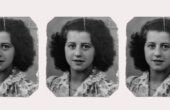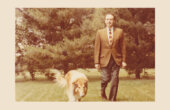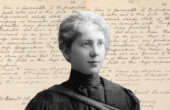Alternative Geometries
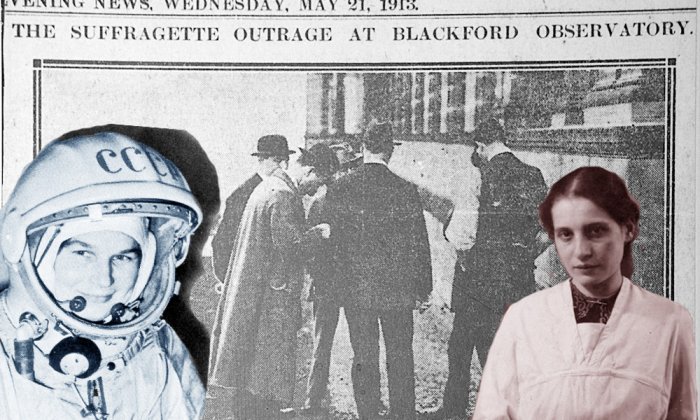
This story is a hybrid of truth and fiction. In 1990, I was a postgraduate student at the Royal Observatory Edinburgh, working towards a PhD in astrophysics. I really did show Valentina Tereshkova around the Observatory, but I don’t remember telling her about the 1913 suffragette bombing (which really did happen; there is a small plaque on one of the Observatory’s towers commemorating it). The other elements of this story are also true. Einstein’s only daughter, Lieserl, was born out of wedlock and never met her father; it’s not known what happened to her but she probably died young. Lise Meitner’s essential work on nuclear fission was denied by her lifelong collaborator Otto Hahn after he alone was awarded the Nobel Prize. My grandmother Lisl fled from Vienna in 1938; she loved making collages from scraps of paper and hated talking about her past.
I wrote the story as an experiment, by bringing together different facts and story elements to see what would result. Much of my writing plays with form, other times I take a more traditional approach. What fuels all of my work is a desire to show that science is a cultural activity influenced by non-scientific social and cultural forces, and as worthy of literature as other human activities.
Let any number of women be represented as points in space and time, and you will always be able to find a surface that connects them. This was what Einstein’s wife, whose name was Mileva Marić, was working on when she fell pregnant with their first child. (The one who disappeared from history. In other words, the girl.)
Nobody has ever bothered to test Mileva Marić’s theory, until now.
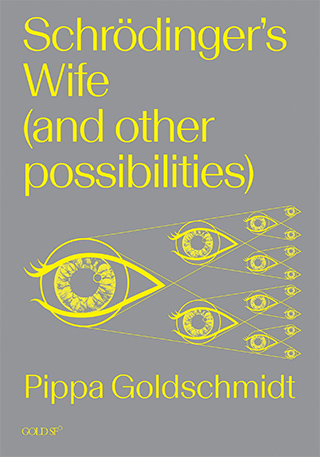
Let the first woman be Valentina Tereshkova, and let her location in the space-time continuum be the occasion of her visit to the Royal Observatory in Edinburgh almost exactly a year after the Berlin Wall has come down. I’m a student at the Observatory, where I calculate how black holes and galaxies form in the early universe, and how to save enough money from my grant to buy some new jeans. On the day that Valentina Tereshkova is invited to the Observatory I’m chosen to show her around, even though I don’t speak a word of Russian and she doesn’t appear to understand English.
I only know one fact about Valentina Tereshkova but it’s an important one: She was the first woman to travel into outer space. Back in 1963 when the Russians were still Soviets and when the Soviets were beating the Americans at the space race, she spent nearly three days orbiting the Earth in a Vostok rocket.
I’ve been instructed to show her the Observatory’s two telescopes, one in each of the copper-domed towers at either end of the building. Nobody has actually looked through these telescopes for many years; in their way they’re now as defunct as the Soviet Union and spend their days waiting for someone to come and dismantle them. We use up-to-date machinery for our research; new telescopes, cameras, satellites and so on, but these are all a long way from the Observatory itself. Right here it’s somewhat more historic, and I imagine that Valentina Tereshkova might have encountered other, similar out-of-date chunks of metal; as I talk to her I picture old space rockets peacefully rusting into the black earth of the Caucasus.
As I talk to her I picture old space rockets peacefully rusting into the black earth of the Caucasus.
Maybe it’s because I know Valentina Tereshkova can’t understand what I’m saying that I start to tell her about the bomb. How, in 1913, an unknown suffragette placed a bomb at the base of this tower, the subsequent explosion damaging the curved wall and injuring the woman herself, who left a trail of blood leading away from the Observatory and down the hill. I even tell Valentina Tereshkova about the handbag found at the scene, which contained some currant buns and a note fastened to it by a safety pin saying “Deeds not words,” the suffragette slogan. I speculate about why the woman didn’t eat the buns before the bomb went off; perhaps she was too nervous or perhaps they were an obscure political statement. Valentina Tereshkova nods at me, probably thinking that I’m explaining my PhD work on distant galaxies and black holes.

That is what I’m supposed to be telling her. I’m not supposed to be telling her about the suffragette bombing, as hidden a history as the black holes themselves, which can only be indirectly inferred from the way they disturb their surroundings, warping space-time into curved surfaces, as predicted by Einstein and subsequent physicists. There is a persistent but undocumented rumor that Mileva Marić helped her husband with some of the trickier aspects of the maths in his work. I too have always been good at maths, and I can write a line of algebra that symbolises a surface extending to infinity in all directions. Valentina Tereshkova never went as far as infinity; in her Vostok rocket she reached an altitude of 200,000 meters, or about 60 times further from sea level than I’ve ever been.
In geometry you need more than one point to define a surface, so let the second point be occupied by the Austrian physicist Lise Meitner, sitting on her bed and scribbling notes in a hotel room somewhere in Stockholm. It is spring 1939. She was born in Vienna in the late 19th century to a Jewish family, and her original name was Elise, mutating at some unknown point in her childhood.
Lise Meitner spends most of her professional life at a science institute in Berlin, where initially she has to work in a basement, separated from the male scientists. (I say “work” but she wasn’t actually paid a salary for the first few years.) Over time she’s allowed to interact with the men, slowly and cautiously at first, in case they run from her like startled deer. She starts a lifelong collaboration with the chemist Otto Hahn, and in 1907 they set up a laboratory together.
At the beginning of the 20th century an elegant experiment showed that almost all of an atom’s mass is concentrated in a tiny nucleus at its center. Sometimes this nucleus emits high energy radiation and particles, transforming itself in the process; the resulting daughter atom is now a different chemical element bearing no trace of its mother substance. It is this radioactive phenomenon that intrigues Lise Meitner.
In 1933 she has been living and working in Berlin for over 25 years and across Germany, Jewish scientists are dismissed from their jobs. Somehow she manages to hold onto hers; perhaps it’s because she’s Austrian and technically not subject to the laws of the Third Reich, or perhaps the relevant officials haven’t noticed her because she’s a woman. There’s no way of finding out the right answer to the question without drawing attention to herself, and that would be very dangerous. But after Germany annexes Austria in 1938 and Austrian citizens automatically become German, she’s altered from one identity to another and now all the laws of the Third Reich definitely apply to her.
The third woman in the continuum isn’t a scientist. Not long after Lise Meitner leaves Vienna for Berlin, my grandmother is born in that city and she is known as Lisl, an adaptation of her birth name Elise. In 1938 Lisl escapes from Vienna to London. At a time when hardly any Jewish adults are allowed to enter Britain from overseas, somehow (I don’t know how) she obtains a visa which gives her permission to get a job as a domestic maid.
Let us imagine her at work, methodically removing the contents of a kitchen cupboard and setting the stacks of cups and saucers and plates and bowls on the floor, before wiping down the cupboard shelves first with a damp cloth and then a dry one. She has to rearrange the crockery in the cupboard several different times before she can close the door, because it will only fit if you do it the single right way and not one of the countless wrong ways. While she works, she is kneeling in front of this cupboard and trying not to think about what is happening in Austria. (But how can you not think when you do a task like this? How can your mind not fly off in all directions?) There’s too much room inside her head and not enough in the cupboard.
In 1938 Lise Meitner escapes from Berlin to Stockholm, where she’s been promised space to work in the physics laboratory at the Nobel Institute. Sweden is neutral territory, she should be safe here. But because the director of this laboratory doesn’t approve of women physicists, she has no official status and, just as in Berlin 30 years before, she’s confined to a basement. In a letter to Otto Hahn she writes, “This place is unimaginably empty. There are no pumps, no capacitors, no ammeters, nothing to do experiments with.”
All she’s managed to bring with her from Berlin are two small suitcases of summer clothes, and now it’s winter and she’s getting colder with every passing day. She writes to Otto Hahn again and asks him to post her woolens and her books. Meanwhile she sits in her basement.
But she’ll manage. After all, she studies the atom. Too small to see even with the most powerful microscope, the atom still has enough space for these fascinating processes she’s spent her life studying. If a nucleus were the size of a house fly, the surrounding atom would be as big as a cathedral. So why complain about being limited to this basement when she can think about what happens when atoms mutate?
The only home she has is a room in a rather down-at-heel hotel. Over the years she’s stayed in many such places, become used to bedrooms with bathrooms a long chilly walk down a corridor, and meals provided at extra cost. Furnished bedrooms with two drawers for her underwear and a wardrobe, or maybe just a hook on the back of the door, for her dresses. A rickety table where she can spread out her books and papers, and a frayed rug on the floor to cover the holes in the linoleum. Small rooms — these rooms are never spacious — that require her to be quiet and orderly and neat. She has learned that this is how single women must live.
Being Jewish in the Third Reich was the first stage of rendering her work invisible.
In 1939, Lise Meitner works on the problem of nuclear fission. Otto Hahn writes to her with baffling information about his latest experiment. When he bombards uranium atoms with neutrons, they seem to mutate into barium. She estimates that every time a single neutron hits a uranium atom, it is capable of breaking up into two smaller atoms of barium and krypton, and releasing more neutrons in a runaway chain reaction. In a bedroom so small she can touch the opposite walls while she is sitting down, and spending days silently by herself because nobody else will talk to her, Lise Meitner completes a calculation that will trigger the future atom bomb.
After the end of the war, when Otto Hahn is awarded the Nobel Prize for their collaborative work and she is overlooked, someone asks her if being Jewish has damaged her career. Lise Meitner answers, “Being a woman is such a huge handicap that my religion has never mattered.” But she is wrong. Being Jewish in the Third Reich was the first stage of rendering her work invisible.
In the same month that I meet Valentina Tereshkova, my grandmother moves into an old people’s home. When I visit her there, I find her sitting at a table and cutting up used greeting cards to make new ones. I watch as she maneuvers the scissors, causing little pieces of colored card to flutter down before she assembles them into a collage. My grandmother chats to me as she does this but she never tells me anything about her past, and about what — or whom — she left behind in Vienna. The collage is such a perfectly constructed flat surface it has no tell-tale gaps.
After I show Valentina Tereshkova around the Observatory, I go home and boil an egg for my supper. I crack open the egg and eat it, and cup the pieces of broken shell in the palm of my hand. A shell that once protected its contents from the rest of the universe; a miniature spacecraft.
The name of Mileva Marić’s lost girl was Lieserl and she was born in 1902, somewhere in Serbia. It’s not known when she died. As space-time expands and carries us all away from each other into our own separate futures, let us remember.
Pippa Goldschmidt is the author of “Schrödinger’s Wife (and Other Possibilities)” (Goldsmiths Press), from which this story is excerpted. She has contributed to various radio programs in the UK and Germany, and has published a number of short stories, poems, and essays in print and online. She regularly reviews books for the BBC Sky at Night magazine and the Times Literary Supplement, and writes cultural criticism for Art Review (online).

